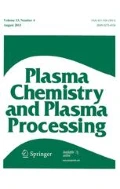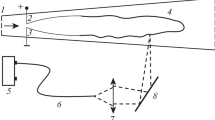Abstract
The paper relates to the investigations of a low-current discharge in a vortex airflow with the electrode configuration corresponding to classical coaxial plasmatron. The gas flow rate is varied from 0.1 to 0.3 g/s at an inner diameter of the plasmatron nozzle of 5 mm. The discharge is powered by dc voltage via a ballast resistor. Typical averaged current is changed from 0.06 to 0.15 A so that a maximum averaged power dissipated in the discharge amounts to 160 W. In these conditions, a luminous gas region at the plasmatron exit, which in most publications is associated with a plasma jet, is observed. The method for the jet diagnostics based on a usage of the additional electrodes at the plasmatron exit has been proposed. The main idea of the experiments is the elucidation of the problem whether the jet actually represents the plasma area or we have to apply the term “plasma” with care. In particular, in the case under discussion the main charged particles in the jet are electrons that are emitted from a plasma column located in the plasmatron nozzle. The model that describes the formation of electron flow in the jet has been proposed. Typical electron density in the jet estimated with a usage of the model is at a level of 109 cm−3.





Similar content being viewed by others
References
Winter J, Brandenburg R, Weltmann KD (2015) Atmospheric pressure plasma jets: an overview of devices and new directions. Plasma Sources Sci Technol 24:064001
Laroussi M (2015) Low-temperature plasma jet for biomedical applications: a review. IEEE Trans Plasma Sci 43:703–712
Park GY, Park SJ, Choi MY, Koo IG, Byun JH, Hong JW, Sim JY, Collins GJ, Lee JK (2012) Atmospheric-pressure plasma sources for biomedical applications. Plasma Sources Sci Technol 21:043001
Jaworek A, Ganan-Calvo AM, Machala Z (2019) Low temperature plasmas and electrosprays. J Phys D Appl Phys 52:233001
Malik MA (2016) Nitric oxide production by high voltage electrical discharges for medical uses: a review. Plasma Chem Plasma Process 36:737–766
Korolev YD (2015) Low-current discharge plasma jets in a gas flow. Application of plasma jets. Russ J Gen Chem 85:1311–1325
Korolev YD, Frants OB, Landl NV, Suslov AI (2012) Low-current plasmatron as a source of nitrogen oxide molecules. IEEE Trans Plasma Sci 40:2837–2842
Korolev YD, Frants OB, Landl NV, Kasyanov VS, Galanov SI, Sidorova OI, Kim Y, Rosocha LA, Matveev IB (2012) Propane oxidation in a plasma torch of a low-current nonsteady-state plasmatron. IEEE Trans Plasma Sci 40:535–542
Serbin SI, Kozlovskyi AV, Burunsuz KS (2016) Investigations of nonstationary processes in low emissive gas turbine combustor with plasma assistance. IEEE Trans Plasma Sci 44:2960–2964
Wang C, Lu ZS, Li DN, Xia WL, Xia WD (2018) Effect of the magnetic field on the magnetically stabilized gliding arc discharge and its application in the preparation of carbon black nanoparticles. Plasma Chem Plasma Process 38:1223–1238
Zhang C, Niu ZT, Ren CY, Li H, Yan P, Shao T (2017) Factors influencing the discharge mode for microsecond-pulse gliding discharges at atmospheric pressure. IEEE Trans Dielectr Electr Insul 24:2148–2156
Groger S, Ramakers M, Hamme M, Medrano JA, Bibinov N, Gallucci F, Bogaerts A, Awakowicz P (2019) Characterization of a nitrogen gliding arc plasmatron using optical emission spectroscopy and high-speed camera. J Phys D Appl Phys 52:065201
Kong CD, Gao JL, Zhu JJ, Ehn A, Alden M, Li ZS (2017) Characterization of an AC glow-type gliding arc discharge in atmospheric air with a current-voltage lumped model. Phys Plasmas 24:093515
Zhu JJ, Ehn A, Gao JL, Kong CD, Alden M, Salewski M, Leipold F, Kusano Y, Li ZS (2017) Translational, rotational, vibrational and electron temperatures of a gliding arc discharge. Opt Express 25:20243–20257
Zhu JJ, Gao JL, Ehn A, Alden M, Larsson A, Kusano Y, Li ZS (2017) Spatiotemporally resolved characteristics of a gliding arc discharge in a turbulent air flow at atmospheric pressure. Phys Plasmas 24:013514
Zhang H, Zhu FS, Li XD, Du CM (2017) Dynamic behavior of a rotating gliding arc plasma in nitrogen: effects of gas flow rate and operating current. Plasma Sci Technol 19:UNSP0454
Korolev YD, Frants OB, Landl NV, Bolotov AV, Nekhoroshev VO (2014) Features of a near-cathode region in a gliding arc discharge in air flow. Plasma Sources Sci Technol 23:054016
Zhang C, Shao T, Yan P, Zhou Y (2014) Nanosecond-pulse gliding discharges between point-to-point electrodes in open air. Plasma Sources Sci Technol 23:035004
Zhang C, Shao T, Ma H, Ren C, Yan P, Zhou Y (2014) Comparison of μs- and ns-pulse gliding discharges in air flow. IEEE Trans Plasma Sci 42:2354–2355
Sobota A, Guaitella O, Sretenovic GB, Kovacevic VV, Slikboer E, Krstic IB, Kuraica MM (2019) Plasma-surface interaction: dielectric and metallic targets and their influence on the electric field profile in a kHz AC-driven He plasma jet. Plasma Sources Sci Technol 28:045003
Akishev Y, Aponin G, Petryakov A, Trushkin N (2018) On the composition of reactive species in air plasma jets and their influence on the adhesion of polyurethane foam to low-pressure polyethylene. J Phys D Appl Phys 51:274006
Engelhardt M, Ries S, Hermanns P, Bibinov N, Awakowicz P (2017) Modifications of aluminum film caused by micro-plasmoids and plasma spots in the effluent of an argon non-equilibrium plasma jet. J Phys D Appl Phys 50:375201
Wang RX, Xu H, Zhao Y, Zhu WD, Zhang C, Shao T (2019) Spatial-temporal evolution of a radial plasma jet array and its interaction with material. Plasma Chem Plasma Process 39:187–203
Fuh CA, Wu W, Wang CJ (2016) Microwave plasma-assisted ignition and flameholding in premixed ethylene/air mixtures. J Phys D Appl Phys 49:285202
Varella RA, Sagas JC, Martins CA (2016) Effects of plasma assisted combustion on pollutant emissions of a premixed flame of natural gas and air. Fuel 184:269–276
Zhang H, Li L, Lia XD, Wang WZ, Yan JH, Tu X (2018) Warm plasma activation of CO2 in a rotating gliding arc discharge reactor. J CO2Util 27:472–479
Du CM, Shang C, Wang T, Li ZM, Yang X, Chen HT, Liu Y, Wang K (2017) A portable plasma sterilizer. Plasma Chem Plasma Process 37:77–97
Li XY, Feng ZQ, Pu SC, Yang Y, Shi XM, Xu Z (2018) Cold atmospheric plasma jet-generated oxidized derivatives of tryptophan and their selective effects on Murine melanoma and fibroblast cells. Plasma Chem Plasma Process 38:919–936
Malik MA, Schoenbach KH, Abdel-Fattah TM, Heller R, Jiang CQ (2017) Low Cost compact nanosecond pulsed plasma system for environmental and biomedical applications. Plasma Chem Plasma Process 37:59–76
Malik MA, Jiang CQ, Heller R, Lane J, Hughes D, Schoenbach KH (2016) Ozone-free nitric oxide production using an atmospheric pressure surface discharge—a way to minimize nitrogen dioxide co-production. Chem Eng J 283:631–638
Malik MA, Hughes D, Heller R, Schoenbach KH (2015) Surface plasmas versus volume plasma: energy deposition and ozone generation in air and oxygen. Plasma Chem Plasma Process 35:697–704
Janda M, Martisovits V, Hensel K, Machala Z (2016) Generation of antimicrobial NOx by atmospheric air transient spark discharge. Plasma Chem Plasma Process 36:767–781
Gao JL, Zhu JJ, Ehn A, Alden M, Li ZS (2017) In-situ non-intrusive diagnostics of toluene removal by a gliding arc discharge using planar laser-induced fluorescence. Plasma Chem Plasma Process 37:433–450
Trushkin AN, Grushin ME, Kochetov IV, Trushkin NI, Akishev YS (2013) Decomposition of toluene in a steady-state atmospheric-pressure glow discharge. Plasma Phys Rep 39:167–182
Zhu FS, Li XD, Zhang H, Wu AJ, Yan JH, Ni MJ, Zhang HW, Buekens A (2016) Destruction of toluene by rotating gliding arc discharge. Fuel 176:78–85
Xiong Y, Zhang Q, Wandell R, Bresch S, Wang HH, Locke BR, Tang YN (2019) Synergistic 1,4-dioxane removal by non-thermal plasma followed by biodegradation. Chem Eng J 361:519–527
Korolev YD, Frants OB, Landl NV, Geyman VG, Matveev IB (2009) Nonsteady-state gas-discharge processes in plasmatron for combustion sustaining and hydrocarbon decomposition. IEEE Trans Plasma Sci 37:586–592
Korolev YD, Frants OB, Geyman VG, Kasyanov VS, Landl NV (2012) Transient processes during formation of a steady-state glow discharge in air. IEEE Trans Plasma Sci 40:2951–2960
Korolev YD, Frants OB, Geyman VG, Landl NV, Kasyanov VS (2011) Low-current “gliding arc” in air flow. IEEE Trans Plasma Sci 39:3319–3325
Korolev YD, Frants OB, Landl NV, Geyman VG, Suslov AI (2017) Parameters of a positive column in a gliding glow discharge in air. Phys Plasmas 24:103526
Korolev YD, Mesyats GA, Khuzeev AP (1980) Phenomena on electrodes preceding the semi-self-maintained space discharge transition into the spark discharge. Dokl Akad Nauk SSSR 253:606–609
Genkin SA, Karlov NV, Klimenko KA, Korolev YD, Kuzmin GP, Mesyats GA, Novoselov YN, Prokhorov AM (1984) Application of mild x-ray-radiation for initiation of self-sustained spaced discharge in larger interelectrode intervals. Pis Zh Tekh Fiz 10:641–645
Kozyrev AV, Korolev YD (1981) A model for the channel formation during the contraction of pulse volume discharges. Zh Tekh Fiz 51:2210–2213
Amirov RK, Barengolts SA, Korostylev EV, Pestovskii NV, Petrov AA, Savinov SY, Samoilov IS (2015) Erosion cell formation in the pulseless negative corona discharge. Bull Lebedev Phys Inst 42:71–76
Shmelev DL, Barengolts SA (2013) Kinetic modeling of initiation of explosion center on cathode under dense plasma. IEEE Trans Plasma Sci 41:1959–1963
Korolev YD, Frants OB, Nekhoroshev VO, Suslov AI, Kas’yanov VS, Shemyakin IA, Bolotov AV (2016) Simulation of nonstationary phenomena in atmospheric-pressure glow discharge. Plasma Phys Rep 42:592–600
Akishev Y, Grushin M, Karalnik V, Petryakov A, Trushkin N (2010) Non-equilibrium constricted dc glow discharge in N2 flow at atmospheric pressure: stable and unstable regimes. J Phys D Appl Phys 43:075202
Akishev Y, Grushin M, Kochetov I, Karal’nik V, Napartovich A, Trushkin N (2005) Negative corona, glow and spark discharges in ambient air and transitions between them. Plasma Sources Sci Technol 14:S18–S25
Janda M, Martisovits V, Bucek A, Hensel K, Molnar M, Machala Z (2017) Influence of repetition frequency on streamer-to-spark breakdown mechanism in transient spark discharge. J Phys D Appl Phys 50:425207
Acknowledgements
This work was supported by the Russian Foundation for Basic Research under the grant 17-08-00636.
Author information
Authors and Affiliations
Corresponding author
Additional information
Publisher's Note
Springer Nature remains neutral with regard to jurisdictional claims in published maps and institutional affiliations.
Rights and permissions
About this article
Cite this article
Korolev, Y.D., Nekhoroshev, V.O., Frants, O.B. et al. Features of the Current Sustainment in a Low-Current Discharge in Airflow. Plasma Chem Plasma Process 39, 1519–1532 (2019). https://doi.org/10.1007/s11090-019-10016-7
Received:
Accepted:
Published:
Issue Date:
DOI: https://doi.org/10.1007/s11090-019-10016-7



